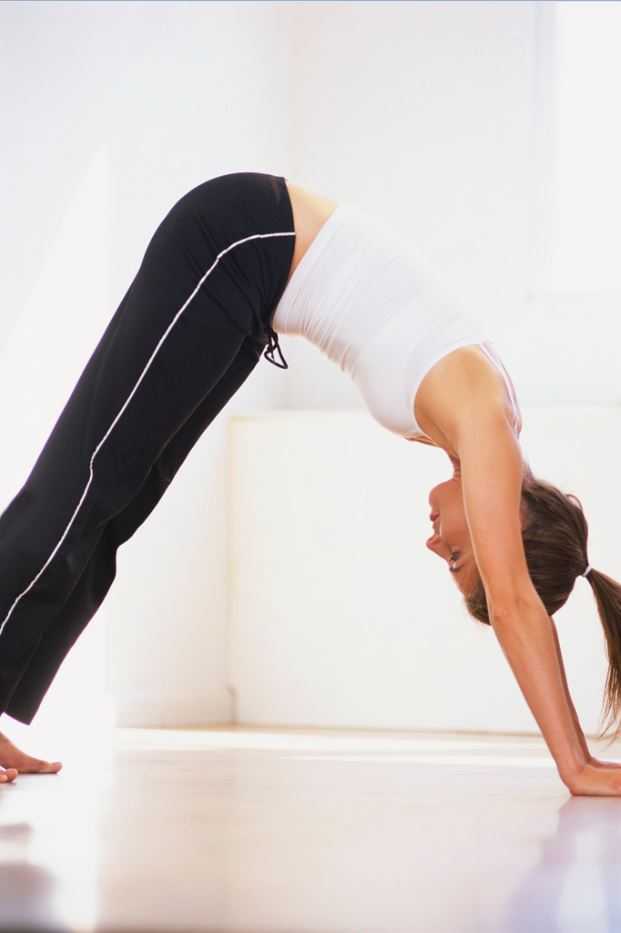Recently in the Pelvic Rehab Report blog we discussed the beneficial role of pelvic rehabilitation for symptoms of dysmenorrhea. Additional research was published this year that supports the use of pranayama for improving quality of life and pain in girls with primary dysmenorrhea. Breathing within yoga studies is a rich field, with well-defined variations in stages and kinds of breathing, techniques and postures, and use of different hand positions and breathing through the nostrils and/or mouth. The Oxford online dictionary defines pranayama as a practice coming from Hindu yoga and related to regulating the breath through specific techniques.

In the study, the practice of both slow pranayama (Nadi Shodhan) and fast pranayama (Kapalbhati) was instructed to the women to be completed in the mornings on an empty stomach for 10 minutes per day. Ninety unmarried young women (ages 18-25) diagnosed with primary dysmenorrhea were randomly and equally assigned to either Group A (slow pranayama) or Group B (fast pranayama). Outcomes included the Moos menstrual distress questionnaire (MMDQ), numerical pain rating pain scale, a quality of life scale "by American chronic pain association" and the assessments were administered at baseline, after the first menstrual cycle, and after the second menstrual cycle. To read more details about the methods and results, the full article can be accessed here.
Prior and recent research has also studied the effects of similar breathing techniques on cognitive functions in healthy adults and also on perceived stress and cardiovascular parameters in young healthcare students. While it may not be new to compare fast and slow pranayama techniques with health conditions, this is the first study to address pranayama's effects on symptoms of dysmenorrhea. The authors conclude that practicing slow pranayama compared to fast pranayama improved quality of life and pain scores related to dysmenorrhea. Furthermore, the authors suggest that because pranayama can decrease absenteeism and stress levels, the practice should be implemented in college students to improve quality of life.
If you are looking to learn more about pranayama and other methods of self-management of conditions including, but certainly not limited to, dysmenorrhea, come to the city-New York City- next month for Meditation for Patients and Providers instructed by faculty member Nari Clemons. It's sure to be hot in the city, so chill out indoors with Nari, and hang out at night with your new favorite colleagues that you'll meet. A benefit of this course is that not only can you learn to care better for your patients, but also for yourselves, and you deserve it.
Today we hear from Herman & Wallace instructor Dustienne Miller CYT, PT, MS, WCS. Dustienne instructs the Yoga for Pelvic Pain course. Join her next month at Yoga for Pelvic Pain, Cleveland, OH on July 18 and 19!

We all know yoga can help chronic headaches, insomnia, anxiety, low back pain, and a myriad of other conditions. How can we apply the principles and benefits of yoga to the treatment of chronic pelvic pain?
Breathing
As rehab professionals who treat chronic pelvic pain, we know how critical it is for our clients to learn how to downtrain the nervous system. Breath awareness and training are a useful tool in reducing sympathetic nervous system override. Some clients may not have the awareness that they are holding their breath because of pain, or even anticipation of pain. Because of the direct mechanical relationship between the diaphragm and the pelvic floor, breath holding can lead to pelvic floor muscle holding. By building awareness, which is a learned skill, the client begins to notice and eventually control non-optimal breathing patterns.
Yoga offers several types of pranayama, or breathing techniques. Integrating breath with gentle movement has proven to be highly beneficial for men and women with chronic pelvic pain. Simple belly breathing lowers heart rate, blood pressure, and anxiety levels. For more detailed instructions on two pranayama, dirgha (3 part breath) and ujjayi (ocean-sounding breath), please click here.
Grounding
Grounding techniques decrease dissociation and anxiety. Two easy postures to practice in the clinic are Seated and Standing Mountain Pose (Tadasana). When practicing Seated Tadasana, encourage your patient to feel the ischial tuberosities heavy into the chair while imagining a string lifting up the spine and through the top of the head. When practicing Standing Tadasana, offer the imagery of a magnetic pull from the soles of the feet into the earth. For more detailed instruction on Tadasana, please click here.
Being Present
Negotiating medical system can leave clients with chronic pelvic pain feeling traumatized. Sadly, the percentage of men and women who have experienced additional traumas (ie: verbal abuse, sexual abuse) are quite high. Training the mind-body-spirit connection is helpful for the client to stay in the present moment rather than think about past painful experiences or anticipate future expectations of pain. Encourage the client to move at their pace and comfort level. Teach them gentle, loving acceptance of themselves and where they are in their healing journey. Clinicians must be mindful to avoid any potential trauma triggers (ie: teaching Supta Badha Konasana, butterfly/adductor stretch, in an open gym area). An excellent book to read to enhance your understanding of the delicacy of this subject is Overcoming Trauma through Yoga by Emerson and Hopper.
Today on the Pelvic Rehab Report, we hear from Dustienne Miller. Dustienne wrote and teaches the Yoga for Pelvic Pain course, which is available in Cleveland, OH on July 18-19, and in Boston, MA on September 12-13.
"It feels like my pelvic floor just sighed."
Grounding in Mountain Pose

As musculoskeletal professionals, we have a sharp eye for postural dysfunction. We explain to our patients that the ribcage is sheared posteriorly to the plumb line and how gravity magnifies forces at specific structures. Some physical therapists perform the Vertical Compression Test (VCT) to allow the patient to feel the difference between their typical habitual posture and a more optimally aligned posture. This works well to “sell” your patients on why their newly aligned posture allows for more efficient weight transfer through the base of support. In addition to the VCT, I utilize Tadasana, or Mountain Pose as an additional kinesthetic approach to postural retraining.
Last week in the clinic, I was teaching my client postural awareness using Tadasana. I asked her to close her eyes, or lower her gaze if she was not comfortable closing her eyes. Working from the ground up, we started bringing awareness to her base of support. She noted that she was standing with her weight mostly in her heels. When I encouraged her to bring her weight forward, hinging from the talocrural joint, she had an “aha moment.” She said, “It feels like my pelvic floor just sighed.” She was unaware that her habitual posture was to stand with her weight mostly posterior to plumb line, thus encouraging her posterior pelvic floor to remain in an overactive state. Once she balanced her body from the ground up, she felt a major release in her holding patterns.
At our follow-up session, the client remarked that her postural awareness increased dramatically. She was surprised at how often her pelvic floor was in a habitual pattern of over-firing. Additionally, she reported increased awareness while practicing standing yoga postures during class. She feels more in control of her body after experiencing embodied optimal alignment and has had success with carrying over postural awareness outside of the clinic setting. Self-awareness and empowerment are two major goals of my physical therapy practice, and using yoga to achieve these goals makes my clinical practice even more enjoyable.
For more info on the Vertical Compression Test, click here. For detailed instruction on Tadasana, click here.

A recent literature review addressing the effectiveness of yoga for depression reports that the positive findings are promising. The 2007 National Health Interview Survey (NHIS) found that yoga was one of the top 10 complementary health approaches used among adults in the United States. (The linked page for the NHIS also includes a video of the scientific results of yoga for health.)
Yoga is not only about bodies bending- ancient yoga traditions offer physical, mental, and spiritual techniques that are designed to be holistic in nature. Many instructors in the US focus on the many physical benefits of yoga, yet there are many types of yoga, many instructors with varied levels of training, and many health issues that require an individualized program of yoga therapy. In relation to the potential effects of yoga on depressive symptoms, theories in neurobiology point to the potential positive effects on the HPA (hypothalamic-pituitary-adrenal) axis, according to the linked article by Lila Louie.
While none of the articles described in the literature review are specific to the one patient group or population, the subjects studied include incarcerated women, older patients, university students, and patients from the general population who struggle with depression. One group of patients known to be at risk for severe depression is postpartum women. The definition of postpartum varies, and a generous definition may include any issue that, once imparted in a postpartum period and left unaddressed, could persist throughout a woman's lifetime. This is commonly seen in the clinic as uncorrected postural dysfunction, pelvic floor dysfunction, or gait changes, for example.
Because both yoga and exercise "appear to ameliorate depression," the author of the literature review states that motivation and compliance towards either modality should be considered during treatment planning for patients. Louie further states that yoga practice of asanas is safe, cost-effective, versatile, and can be used on its own or as an adjunct to medication. If you would like to learn more about the use of yoga for the postpartum population, sign up for Ginger Garner's continuing education course: Yoga as Medicine for Labor and Delivery and Postpartum offered in Seattle in August. To read about Ginger's Yoga as Medicine for Pregnancy course, click here.
H&W instructor Dustienne Miller, CYT, PT, MS, WCS wrote this post.

As specialists in pelvic health, we have the honor of being trusted with very private information. Our patients trust us with their secrets, their emotions, and their bodies. Sometimes patients reveal traumatic personal stories, both past and present. Even if our patients have not suffered emotional, physical, or sexual abuse, we can assume that the diagnosis of pelvic floor dysfunction is traumatic itself. Bouncing from clinician to clinician and inability to share their pain and experience with coworkers and friends is enough to increase baseline anxiety and depression levels. Yoga has proven to be an effective method in helping to heal Post Traumatic Stress Disorder and other mental comorbidities associated with pelvic floor dysfunction. But where do you start? How do you make your patient feel safe?
In David Emerson and Elizabeth Hopper?s book Overcoming Trauma through Yoga, there is guidance on how to appropriately guide your patient or yourself through a yoga program that feels safe and appropriate. As clinicians, we are very aware of monitoring patient response in the treatment room. If we notice guarding or dissociation we do not continue the session according to the goals we have set for the patient, rather we meet the patient where they are at that time on that day and work accordingly. I recommend we utilize the same sensitivity with our patients when creating a home program and working with our patients in open gym areas. What might feel great for us (ie: downward facing dog) may trigger trauma for another. Be mindful of the transition from the emotionally charged manual treatment to a less contained room like an open gym. Instructing a patient in pelvic tilts and bridging with other people around could trigger an emotional response, especially if their emotions were primed after myofascial release in the pelvis and abdomen. Bottom line: take the sensitivity you have at the plinth and carry it over into the exercise component of your treatments. Your patient will lead the way.
Dustienne Miller is a board certified women?s health clinical specialist and Kripalu Yoga teacher. She is the creator of the DVD Your Pace Yoga: Relieving Pelvic Pain, a musical theatre performer, and a terrible cook. Her two day class offered through Herman and Wallace, Yoga for Pelvic Pain, is being offered in San Diego next March.













































